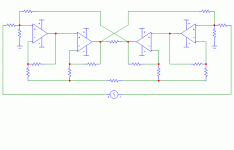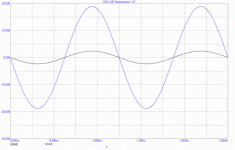jh6you said:
Sure that VF works with the error voltage between the +/- inputs while CF does with the error current. I understand that the basic idea of Supper-Symmetry in this thread has been started based on the condition that the left and right op amps should communicate each other with current. In this respect, CF is now deemed to be better for us to achieve the goal. As you might know very well, I tried with VF, so far with no success. Sometimes the practice unlikely follows the theory.
JH
Beg to differ. The practise ALWAYS follows the theory (assuming the theory is correct, of course). It's just that sometimes we don't grasp the theory until we find how it really works in practise. No offense meant, but the fact that you cannot get it to work with VF so far doesn't prove to me that there is something wrong with the theory. But I DO asppreciate that there are some clever things in your amp.
"There is nothing so practical as a really good theory" -- Ludwig von Bolzmann
janneman said:
The practise ALWAYS follows the theory (assuming the theory is correct, of course).
If not, maybe it is due to human error. 😉
JH
Guys
If you (having a nice main system) have components sleeping around you, just wake them up, and build this simple sub amp. Try this well-known CD and you will do . As I have informed you earlier, my line stage is the unbalanced tube SRPP. Soon, I will try with BOSOZ having the balanced outputs.
. As I have informed you earlier, my line stage is the unbalanced tube SRPP. Soon, I will try with BOSOZ having the balanced outputs.
JH
If you (having a nice main system) have components sleeping around you, just wake them up, and build this simple sub amp. Try this well-known CD and you will do
 . As I have informed you earlier, my line stage is the unbalanced tube SRPP. Soon, I will try with BOSOZ having the balanced outputs.
. As I have informed you earlier, my line stage is the unbalanced tube SRPP. Soon, I will try with BOSOZ having the balanced outputs.JH
Attachments
Re: Re: Re: Re: Re: Msscf
JH,
Who says that I don't understand your circuit ?
The offset problem has nothing to do with supersymmetry.
If you understand your circuit, why do you still have more offset than me ? 😉
Everybody just wants to help you to get rid of your offset, but you take critics on your circuit personal and try to do it yourself.
JH,
jh6you said:
Bernhard
You know my circuit without understanding it.
JH
Who says that I don't understand your circuit ?
The offset problem has nothing to do with supersymmetry.
If you understand your circuit, why do you still have more offset than me ? 😉
Everybody just wants to help you to get rid of your offset, but you take critics on your circuit personal and try to do it yourself.
Guys, Guys, don't spoil this wonderful thread. 😕
There are now three amps working, all unique creations. 😉 😉 😉
Everyone has the right to do the things like he wants to and how he thinks is best, even when theory and practice don't meet.
We are all happy with what we made, so please don't argue now, which one is best or not...
Enjoy them!!! (And tell me I’m right) 🙂
/Hugo - Enough trouble in the world for the moment.
There are now three amps working, all unique creations. 😉 😉 😉
Everyone has the right to do the things like he wants to and how he thinks is best, even when theory and practice don't meet.
We are all happy with what we made, so please don't argue now, which one is best or not...
Enjoy them!!! (And tell me I’m right) 🙂
/Hugo - Enough trouble in the world for the moment.
Netlist said:[snip]Enjoy them!!! (And tell me I’m right) 🙂
/Hugo - Enough trouble in the world for the moment.
You are right.

Jan Didden
Quite correct
No reason for anyone to get upset - but we should all understand that we have personal investments in our work. When you work this hard on something, you can get emotional attachments. So be mindful of others when posting on their designs.
(I have something that works in the sense that it puts out a signal, but with only small gain and a lot of heat at the moment. Too much time at work, not enough time to play.)
No reason for anyone to get upset - but we should all understand that we have personal investments in our work. When you work this hard on something, you can get emotional attachments. So be mindful of others when posting on their designs.
(I have something that works in the sense that it puts out a signal, but with only small gain and a lot of heat at the moment. Too much time at work, not enough time to play.)
Re: Quite correct
Carry on!!

/Hugo
Sawzall said:
(I have something that works in the sense that it puts out a signal, but with only small gain and a lot of heat at the moment. Too much time at work, not enough time to play.)
Carry on!!

/Hugo
Bernhard said:
By the way, in your circuit the ground connection we were talking about, is made also: the 100ohm that go from output to ground, IMHO useless and on the wrong place.
Should be on the -inputs.
R21 and R22 (100 ohms) are arranged not to make the absolute dc null, but to consider the absolute dc "drift" as suggested by Nelson Pass.
"I suggest you start by loading each output to ground through 100 ohms or so. This will add some stability to the absolute DC drift so that when you make the other adjustments it will tend to stay put."
In my case, R15 and R16 control the value of absolute dc. This is merely one method among many others. In course of searching this method, I get to become more (not fully) understandable about the original conceptual YAMX2 of Nelson Pass. Yeah, I like to compete "constructively" with Gainclone, wishingly without internal conflicts in this thread.
JH
PS. I would like to give my YAMX2 an identification name. Any comment or suggestion? Probably, Bernhard could give me one. Even a bad name would be welcomed. 😉
JH,
It could be JLH Amp.
Just Like Heaven
ie: Great sounding amp, a nod to The Cure too,
probably my favoriet song 🙂
(hopefully you know who the Cure are?)
/moe29 wishes he could build amps from scratch too!
...has to be content with following directions 😉
m.
It could be JLH Amp.
Just Like Heaven
ie: Great sounding amp, a nod to The Cure too,
probably my favoriet song 🙂
(hopefully you know who the Cure are?)
/moe29 wishes he could build amps from scratch too!
...has to be content with following directions 😉
m.
Re: Quite correct
I made a sim, based on Rookie's schematic.
I was just playing with resistors and their values, not a single cap came in.
Little by little a nice sinewave showed up in transient analysis,
the gain increased, until I could no longer wait to post some results.
The drawing is a mix of everything; Nelson's original idea, Rookies
schematic, the datasheets of the AD811/OPA544 ( the sim has no
OPA549, for the moment) and the bits and peaces I learned from you all.
The source is a 1Khz 2.1Vpp sinewave and the load is an 8ohm resistor. I(load) and V(load) are shown in a separate picture.
The resistor values are hidden for now, not to influence anybody.
I would very much appreciate the input, (Nelson, Sawzall?) from everyone.
Perhaps its not even an X, and far away from SuperSymmetry…
/Hugo – waiting for feedback, but working in the meantime.
Sawzall said:
I have something that works in the sense that it puts out a signal, but with only small gain and a lot of heat at the moment.
I made a sim, based on Rookie's schematic.
I was just playing with resistors and their values, not a single cap came in.
Little by little a nice sinewave showed up in transient analysis,
the gain increased, until I could no longer wait to post some results.
The drawing is a mix of everything; Nelson's original idea, Rookies
schematic, the datasheets of the AD811/OPA544 ( the sim has no
OPA549, for the moment) and the bits and peaces I learned from you all.
The source is a 1Khz 2.1Vpp sinewave and the load is an 8ohm resistor. I(load) and V(load) are shown in a separate picture.
The resistor values are hidden for now, not to influence anybody.
I would very much appreciate the input, (Nelson, Sawzall?) from everyone.
Perhaps its not even an X, and far away from SuperSymmetry…
/Hugo – waiting for feedback, but working in the meantime.

Attachments
Not sure..
of what you posted NetList. Why the connections on the inverting inputs to the 811 to 811 wire? Why not take them to ground?
I will spend some time tomorrow cleaning up the mess I have of a schematic and post it. I am sure that I would get better suggestions if someone could see what I was doing. It seems to be an oscillation - like the 811 was chasing the signal as opposed to settling down into it. I don't have the right words, but that seems to be it. It would also help if I had a scope at home - I can analyze Ku Band (up to about 20GHz, I think) signals at work, but it does not help me here. Looking for a deal now....
of what you posted NetList. Why the connections on the inverting inputs to the 811 to 811 wire? Why not take them to ground?
I will spend some time tomorrow cleaning up the mess I have of a schematic and post it. I am sure that I would get better suggestions if someone could see what I was doing. It seems to be an oscillation - like the 811 was chasing the signal as opposed to settling down into it. I don't have the right words, but that seems to be it. It would also help if I had a scope at home - I can analyze Ku Band (up to about 20GHz, I think) signals at work, but it does not help me here. Looking for a deal now....
From the Aleph-X thread:
Does that mean, even with 20V rails we're still a little bit low ? 😕
25V minimum ? 😕
Better use bipolar ? 😕
Nelson Pass said:
Like tubes, Mosfets prefer the higher voltages. When you look at the variability of the input capacitance you see that below 5 volts Drain-Source it's not very linear. You should plan for linear operation within an envelope which is at least 5 volts inside the rail voltages, and more is preferred.
Not that you can't run the output right up to the rails; it's not hard to get within a volt, but if you look at the distortion characteristic or listen to it, it's not very pretty.
Originally posted by Nelson Pass
12 volts is a bit low, even if you mean +/- 12 volts. The Mosfets like some extra voltage the same way they like some extra bias, and I would expect only 10 to 15 watts, and not particularly good watts, either. The minimum I work with is +/- 25 volts, and of course you can get higher voltage switching supplies...
Does that mean, even with 20V rails we're still a little bit low ? 😕
25V minimum ? 😕
Better use bipolar ? 😕
Netlist,
maybe you like to put my madness circuit on the sim too 🙄
My idea was to have classA at all power levels.
But without having classA idle current all the time.
The additional circuitry in the center works parallel to the basic OPs.
It modulates the idle current.
If you measure the idle current while having a sinus on the input, the idle current will be a sinus too.
More current flows through all the bias resistors / transistors when there is a signal.
If you leave out the basic OP circuitry it should work like this:
There is normal idle current.
If there is a signal, the idle current will go higher on both sides accordingly to the signal.
No input signal --> Normal idle current.
Full input signal --> High idle current.
So no output signal, no DC offset, just modulated idle current.
IMHO this means classA all the times, but low power dissipation when low signal or low signal.
Paralleled output devices will be required.
May be all this is nonsense
maybe you like to put my madness circuit on the sim too 🙄
My idea was to have classA at all power levels.
But without having classA idle current all the time.
The additional circuitry in the center works parallel to the basic OPs.
It modulates the idle current.
If you measure the idle current while having a sinus on the input, the idle current will be a sinus too.
More current flows through all the bias resistors / transistors when there is a signal.
If you leave out the basic OP circuitry it should work like this:
There is normal idle current.
If there is a signal, the idle current will go higher on both sides accordingly to the signal.
No input signal --> Normal idle current.
Full input signal --> High idle current.
So no output signal, no DC offset, just modulated idle current.
IMHO this means classA all the times, but low power dissipation when low signal or low signal.
Paralleled output devices will be required.
May be all this is nonsense

Bernhard,
Your idea is not a nonsense at all, actually it is implemented in some commercial products (Electrocompaniet). When I said that your schematic looks senseless to me, I didn't see the purpose of the additional op-amps, because it's hard to read your schematic. Maybe the implementation is not correct, but the idea is good.
Regards
Your idea is not a nonsense at all, actually it is implemented in some commercial products (Electrocompaniet). When I said that your schematic looks senseless to me, I didn't see the purpose of the additional op-amps, because it's hard to read your schematic. Maybe the implementation is not correct, but the idea is good.
Regards
Ok, I have revised my madness circuit.
There was one big error.
I don't know if it will work now, its a circuit for diskussion. 🙄

How it should work in detail:
If we put a static 1V input signal on the +input of the amp (left side input)
additional current will flow through: R6 R17 IC1 R9 IC4 R31 R4.
If we put a static -1V input signal on the +input of the amp (left side input)
additional current will flow through: R6 R17 IC4 R9 IC1 R31 R4.
Now IC1 must take care of the introduced (by IC1 and IC4) DC offset too...
There was one big error.
I don't know if it will work now, its a circuit for diskussion. 🙄

How it should work in detail:
If we put a static 1V input signal on the +input of the amp (left side input)
additional current will flow through: R6 R17 IC1 R9 IC4 R31 R4.
If we put a static -1V input signal on the +input of the amp (left side input)
additional current will flow through: R6 R17 IC4 R9 IC1 R31 R4.
Now IC1 must take care of the introduced (by IC1 and IC4) DC offset too...
- Status
- Not open for further replies.
- Home
- Amplifiers
- Pass Labs
- Monolithic SuperSymmetry with Current Feedback



